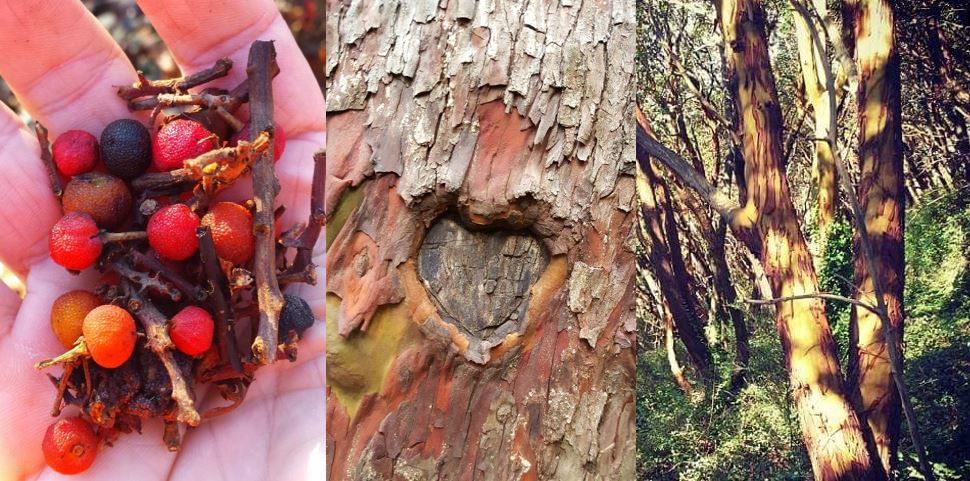
History of Seattle’s Madrones
In the late 1800s, explorers mistakenly named Seattle’s Magnolia area after seeing an abundance of broadleaf evergreen trees common to the Salish Sea and Puget Trough – Arbutus menziesii or Pacific madrone. Nurtured by nature, we do have a couple pure stands of the tree in the city, but we most often find madrone as part of a special plant community speckled heavily with Douglas-fir along with an understory of salal, honeysuckles and evergreen huckleberry.
The species historically ranges from southwestern British Columbia to the Sierra Nevada. Here in Seattle, the tree occupies unique Puget Sound bluff declivities. In my opinion, it is the most gorgeous, distinctive native tree we have – its main stem(s) twist and lean, and its bark characteristically can display orange, green, red to deep brown cinnamon colors, peeling with age. Madrones have flat, glossy leaves the tree retains throughout the year. Certain birds dine on the largish red berries and inhabit its cavities of decay. Native Americans utilized the berries, leaves and bark for culinary and medicinal purposes. Unfortunately, thinning stands, soil loss and compaction, fire suppression and other urban impacts increase susceptibility of this species to diseases, leaving it vulnerable to heart rot, butt rot, leaf diseases and cankers. Despite all the threats and challenges, forests of madrone are worthy of expanded protection and restoration.
Vision
With a renewed and growing interest in this protecting and conserving this iconic tree, we have decided to launch the Madrone Recovery Project. We hope this will become a venture contributing to the restoration of the unique mixed conifer-broadleaf ecosystem throughout Seattle’s forested parklands, supporting a healthy urban ecosystem through collaboration with local partners and stakeholders.
This statement rolls up to help us meet the much larger goal outlined in the Green Seattle Partnership 20-Year Plan Update: Restore and maintain the forested parklands and designated natural areas of Seattle [including the madrone forests.]
Who cares?
Part of getting this project off the ground is to re-inspire some hope and composure about the outlook of madrone trees and forests. Although it is a magical tree, we hope to partially demystify madrone. The following are some urban myths you may have heard (along with my rebuttals):
-
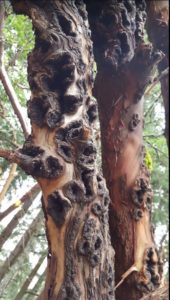
Cankers and dieback are serious problems for tree health, which often occur in urban areas
They are all sick. Cankers, lesions and browning leaves are outward expressions of various plant pathogens that transmogrify this already unique-looking tree. Sadly, the species is on the decline across its native range, but they are not all sick and dying. We see healthy trees and patches in the city and around the Puget Trough. If you are not a believer, let me know and I will send you some pictures.
- If they are leaning, they are going to fall over. The species show a great deal of plasticity as they grow and advantageously reach for available light. A little (or even a big) lean doesn’t necessarily mean the tree(s) will fail. Reputable arborists can properly assess risks associated with any leaner.
- It is hard to grow. Some horticulturalists have refined some propagation methods that are specific to the species. We are long overdue to share this knowledge with each other – and always willing to learn more.
- It is hard to transplant. We are pleased to be acquainted with many talented greenthumb folks, and our team and volunteers have successfully transplanted plugs/seedlings into larger containers for later planting in greenspaces.
- Not a lot of nurseries grow it. Maybe this is because of the reasons mentioned above…. If outside growers cannot provide, we can grow it ourselves – in the greenhouse, or in our backyards!
Where are Seattle’s Madrones?
There are places in our town where you can set out on foot and end up in a friendly-neighborhood madrone forest. Commonly found near the saltwater on bluffs and ridges, ecologists carrying out the 1999-2000 Seattle Urban Nature Project survey of public lands encountered the following: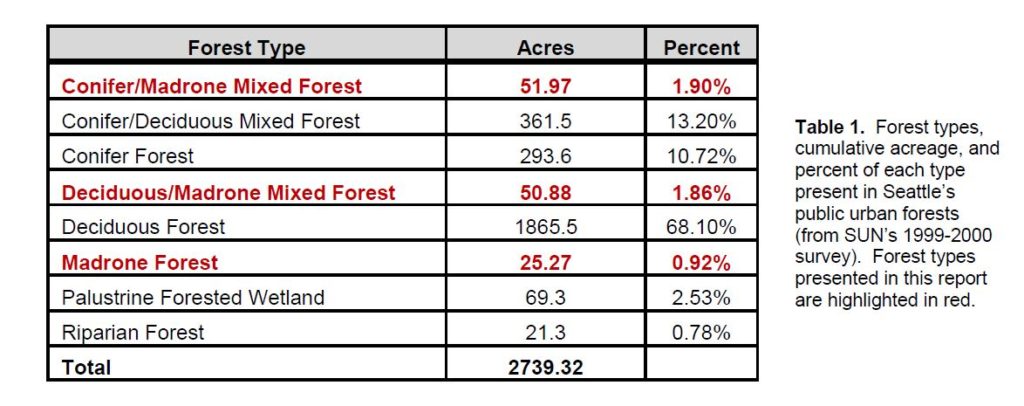
What is better than having another place to explore Seattle Parks? Here are 10 stunners. One can discover magical madrone wonderlands in natural areas such as Seward Park, Lincoln Park, Westcrest Park, Discovery Park, Magnolia Boulevard, Frink Park, Northacres Park, Camp Long, Seola Park and Arroyos Natural Area. If you are tracking along at home, Seattle has a madrone forest with your name on it – with greater likelihood of finding them closer to the salt water. My advice: go ahead and explore them with friends and family. I fear that if people don’t experience these places, we may not fully appreciate them or protect them when the time comes.
Reference Ecosystems
In characterizing different parks and restoration zones, we have designated over 200 acres of Seattle’s 2500 acres of forested parkland as Mixed Conifer Broadleaf Evergreen Forests. This forest type is one of GSP’s more uncommon reference ecosystems. We honor forests indigenous to the Puget Trough by tapping into data from known plant communities. Then, we apply that information to restorations where we know or think particular forests historically occurred. Much of our information on reference ecosystems comes from the treasure-trove at the Washington Department of Natural Resources Natural Heritage Program. We also capture local knowledge and expertise as our program progresses over the years. While most of our projects are focused on building the more common PNW upland Douglas-fir – Western hemlock forests, we also adapt our practices to conserve and restore the relatively obscure wetlands, riparian corridors, shorelines, oak forests and madrone forests that we cherish.
What Shall We Do?
Conserve Mature Madrone
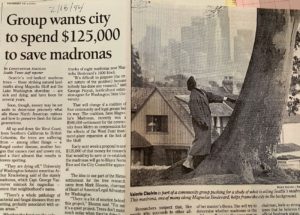
Seattle Times news article from February 18, 1994. Found in the Magnolia Community Club archives at the UW Special Collections.
The Madrone Recovery Project should build on a legacy of research and local knowledge while also contributing to the regional body of information about madrone forests. Much of what we know historically about madrones locally arose out of independent and grant-funded research in the 1990s culminating in a symposium about the urban decline of madrone held at University of Washington’s Center for Urban Horticulture in 1995. Homegrown supporters included the now-defunct group called Save Magnolia’s Madrones. Washington State University Extension gathered partners and stakeholders together again only a few years back for the April 2016 Future of Madrone Symposium. Participant brainstorming reinforced some ongoing concerns about the local health of the species from more recent studies. Importantly, the gathering spurred some action, leading to the creation of a survey and database dedicated to learning more about the condition of madrone.
Starting in 2018, Seattle Parks will support the administration of the Pacific Madrone Survey, originally designed by Washington State University Extension. Staff, partners, and citizen scientists will have the opportunity to contribute data with the intent of understanding both how this species is tolerating myriad diseases and to identify healthy tree populations. Surveyors pinpoint tree health on the map, so it could also help inform us about the true range of the species along our Western coasts.
Increase Planting Numbers of Madrone
Resprouting madrone or the presence of seedlings are indicators of a forest that will continue to sustain itself without much intervention from people. New seedlings represent a future forest, and we focus some of our activities on actively replanting restoration sites where tree regeneration has stagnated. Supported by local seed collection, we will explore all the best methods for direct seeding madrone and local propagation so we can grow baby seedlings. This plant material will go directly into the parks named above and more!
Restore and maintain the forested parklands and designated natural areas of Seattle, including the madrone forests. One can expect GSP to touch to all these natural areas by the year 2025, with ongoing stewardship and maintenance indefinitely.

Baby madrones transplanted from plugs into a deeper pot backfilled with gravel
Develop Best Management Practices
We will admit to some truth in the myth that madrones are finnicky. They grow in conditions where other plants can’t thrive. We can’t just cut off a branch and stick it in the ground to see a new tree grow like we can with other species either. We are long overdue to create at least a “factsheet,” if not a whole set of Best Management Practices particular to madrone establishment and Mixed Conifer and Broadleaf Evergreen ecosystems.
In coordination with Washington State University Extension and other partners (hopefully, hint, hint, wink, wink) , we will develop and publish a guide related to conservation, restoration and monitoring of Puget Sound madrone forests. Topics we could cover include, but are not limited to: propagation techniques, general care and maintenance, disease identification/troubleshooting, wildlife/pollinator interactions, and cultural significance of the species.
The Future of the Madrone Recovery Project
This species-specific approach to conservation will provide new and creative approaches to restore this unique forest type and promote biodiversity. Above, I distilled the Madrone Recovery Project down to a few broad activities where we could have the most impact. In time, we will break it down into more discrete, manageable activities. And with more collaboration, there are some interesting and complementary questions/projects for people to explore, such as:
- Monitoring phenology and disease progression throughout the seasons in a variety of sites.
- Seedling performance (survival of plantings) in the restoration outplanting sites. Feedback could improve future propagation materials and methods.
- Extremely dry summers, particularly followed by very wet seasons, can have lasting effects on madrone forests capacity to resist environmental change and resiliency to a variety of stresses. Will climate change offer opportunities for the species’ range to shift north? Should we send seedlings to botanical gardens outside is current or “natural” range while conservation is still optional?
- The role of fire and other “natural” disturbances affects soils, plant community composition, etc. How could we mimic the varying scope and scale disturbances to promote regeneration of trees and forests?
Stay tuned for more about madrone. Because, we are going to get busy and escalate our madrone forest restoration efforts.
In the meantime, you may wish to read and meditate on the electronic sources of information linked above or below:
- Washington State University Puyallup. Pacific Madrone Research. https://ppo.puyallup.wsu.edu/pmr
Let me know if you have ideas, comments or desire to collaborate at michael.yadrick@seattle.gov
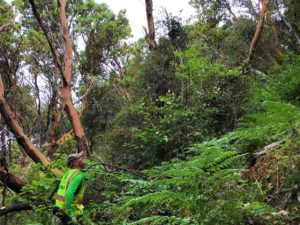
Deep into surveying the rare, pure madrone stands of Arroyos Natural Area

Does anyone know where we can purchase young Madrones? I have a 1.5 acre forest in Tukwila and would love to plant a couple.
Good for you, Chris! Woodbrook Nursery in Gig Harbor may have plants http://woodbrooknativeplantnursery.com/. Also, Firetrail Nursery in Snohomish http://www.firetrailnursery.com/
Chris, did you get your needed trees?
I currently have DOZENS of young volunteer madrona trees growing in my yard!! Help me save them!! They can’t stay put! Plant Amnesty won’t even take them because of the transplanting difficulties. I can’t bear to just rip them out!! Please send a rescue mission!
We could possibly plan an extraction. Please email info@greenseattle.org and someone will touch base with you.
Fourth Corner Nurseries in Bellingham have a great selection of Pacific Madrones. I have planted many of their stock with great success (now going on 4 years). Here’s their info:
fourthcornernurseries.com 360-734-0079. Hope this helps. It’s one of the hardest trees to transplant and keep alive and I’ve planted hundreds of other trees over the years.
Dave Oicles, Park Ranger-Certified Arborist
City of Anacortes Parks 360-661-3554
You’ve made me think a madrone nursery could be in my future retirement plans. Such a magnificent tree. They are beautiful in Josephine County Oregon where my son lives.
That sounds like a great way to spend retirement!
There are several hundred madrone on Penn Cove on Whidbey island. I’m interested in how to survey them. wsu suggested treesnap which seems more useful for individual trees.
Hi Jim
Treesnap is the principal way we are collecting data because it is so easy to manage. It is geared more towards individual trees, though there is a way to submit more than one observation or a group of trees. Feel free to email arbutusarme@gmail.com and we will set you up. I assume you’ve already found this website? https://ppo.puyallup.wsu.edu/arbutus-arme/
Ok just found the multiple tree survey site for madrones. Not sure how to identify trees in dense pacts. They are on and over a bluff
I’m searching for a nursery that sells the Marina Madrone variety, which I’m hoping might be a bit easier to grow in our yard. So far, I’ve had no luck finding it, though! Any ideas?
Woodbrook Native Plant Nursery in Gig Harbor is one nursery that generally has them. You could also check Seattle Native Plants or Go Natives! in the Seattle area. A resource list, with nurseries, is probably something good we could add to the Arbutus ARME website https://ppo.puyallup.wsu.edu/plant-disease/madrone/arbutus-arme/
I have a very steep hillside behind my beachfront cabin which I am attempting to propagate with pacific madrone. This year I planted six plants and 30 seeds. Next year I will plant another dozen live plants. I plan to continue this each year until they are fully established.